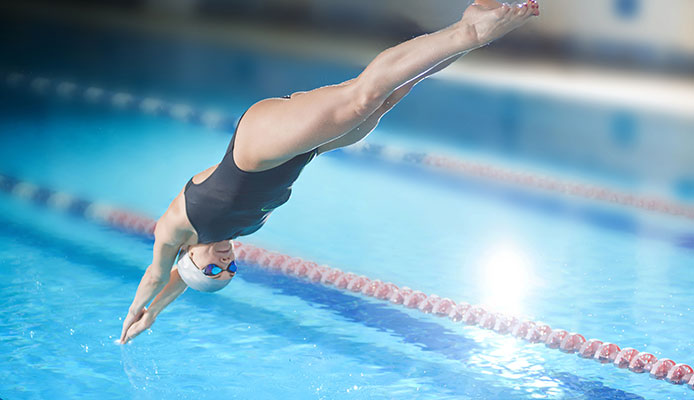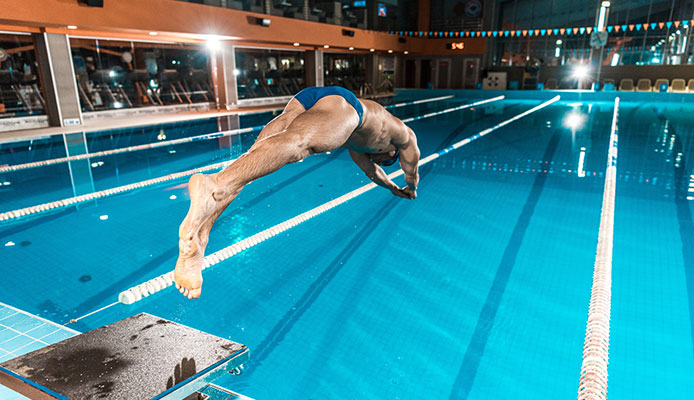
Learning how to dive into a pool is important to prevent injuries. The goal is to land with your head-first and not with your abdomen. Otherwise, you can end up with significant damage to your neck and back, among other problems.
Diving can be intimidating, especially for new swimmers. To make things easier, keep on reading and we’ll let you know what to do. Read on and learn the basics of pool diving so that you can do it the right way!
A Step-by-Step Guide on How to Dive into a Pool
If you are diving for the first time, we got you covered. Here are the simple steps that you have to follow. You might not get it right on the first try, but do not be discouraged. Like anything else, practice makes perfect.
-
Look for a Pool that is Safe for Diving
The first and one of the most important things to do is to find the right diving pool. At a minimum, the depth of the swimming pool should be at least nine feet to be considered safe for diving. This means that you should avoid above ground swimming pools since they are too shallow.
If you are unsure about the depth, don’t dive. It’s better to be safe than sorry. You cannot tell how deep the pool is just by looking at it.
-
Visualize the Dive
Now that you found the right place to go diving, prepare yourself mentally. It is normal for beginners to be anxious. Do not let your fear be bigger than your desire to dive. The thought of getting your head into the water can incite fear.
-
Jump in the Water with Your Feet First
To eliminate any fear, start by jumping into the water with your feet first. Once you are in the water, get yourself acquainted with the feeling. Practice how to swim faster, improve your strokes, and learn how to float. Do the things that will make you feel more comfortable with the thought of being in the water and getting in it head-first.
-
Sit by the Pool with Your Feet Against the Wall
For most beginners, standing on the edge of the pool and diving can be intimidating. Take things slowly. With this, you can start diving from a sitting position. This will be less intimidating compared to standing on the edge of the swimming pool.
Sit on the pool’s edge with your feet on the wall. Raise your hands above the head with palms touching. Slowly get into the water with your hands in an arrow position. Once it is in the water, keep the position for three to five seconds.
-
Sit with Your Feet on the Edge of the Pool
Now, take this step a notch higher by sitting with your feet on the lip of the swimming pool instead of being dipped in the water. You will bend until your buttocks are touching the heels. Like your earlier position, your arms should be above your head, palms touching each other, and maintain an arrow position. Push yourself into the water and slowly straighten your arms and legs.
-
Dive from a Kneeling Position
Another great way to learn how to dive into a pool is to start diving from a kneeling position. Like diving from a sitting position, this is a great way to get rid of your fear. Be as close to the edge of the swimming pool as possible. Assume the crouch position on one knee. Position your arms straight ahead. Your head should be down. Slowly lean forward, push yourself against the wall with your dominant foot, and enter with your fingers touching the water first.
-
Dive in a Standing Position
Now that you are acquainted with how to do it while sitting and kneeling, it’s time to move to do it while in a standing position. To make it less intimidating, consider having a spotter next to you. If you are in a public place, take note of the swimming pool etiquette so that you won’t bother others around.
Before you dive, start assuming the right position. Your lead foot should be on the rim of the pool. This will make your toes slightly on the edge. Your back foot, on the other hand, should be flat on the ground.
While standing, raise your hands above the head. While doing this, your elbows must be straight. Your upper arms should be tucked against the ears. Your chin should also be tucked in your chest.
Push yourself into the pool and dive. Do not merely tip forward and pull. This can result in an injury. Instead, use your lead foot to push yourself in the water. When you enter, the fingertips must be the first ones to touch the water. See to it that your legs are straight. Once you are in the water, start swimming as you normally would. From how to do a flip turn in swimming, learn various techniques to carry yourself well in the water.
-
Dive from a Block
In learning how to dive into a pool, you should start with the basic techniques mentioned above. Eventually. However, there is nowhere else to go but up. This means that you should try advanced techniques once you are already comfortable diving.
Dive in a starting block. This is a block that is raised above the surface, a common feature that you will find in competitive swimming. Start in a crouching position. Use your toes and fingers to grip the edge of the block. Your body should be streamlined before you dive into the pool, which will help in minimizing splash.
-
Start from a Diving Board
Aside from a block, you can also try starting on a diving board. This will let you dive from a high position. To be safe, make sure that the depth of the water is at least 12 feet.
You might also like: Best Pool Lounge Chairs
-
Learn Advanced Diving Techniques
Once you have mastered the basics, one of the advanced techniques that you might want to try is the jackknife. You will rise from the diving board, fold forward, and go straight to pool diving. The belly flop, swan dive, cannonball, and backward somersault are other advanced techniques that you can try once you are confident that you have already mastered the basic diving skills.
Pool Diving Tips and Tricks

Now that you know how to dive into a pool, it will also help to keep in mind the things that will be briefly mentioned below.
- It all starts with learning how to stand properly when you are at the edge of the swimming pool. This will set the tone for the dive. Your body should be straight with a slight arch in your back. Raise your arms above your head with your palms held together, closed, and pointed in an arrow position.
- Keep your hands in front of you when you are diving. Your hands will help you steer once you are in the water. This will also prevent your head from bumping into the pool’s wall. While your hands are in front, make sure that you keep them straight.
- Do not dive from the shallow end of the pool. The minimum depth of the pool should be none feet. With this, don’t dive from an above ground pool as the latter is traditionally shallow. There is a high risk of fractured bones and head injuries when you dive in a shallow pool.
- Do not dive from an elevation other than a diving block or board. Even if you have seen it in the movies, never dive from the roof or a balcony. It might seem like a thrilling act at first, but once you are injured, you will surely regret doing it.
- Learn proper breathing techniques. Even when you are on the edge of the pool, the right breathing can do a lot to help you stay calm and eliminate fears that you might have. Once you are in the water, breathing properly will make sure that you can move with ease.
- Watch and observe. As a beginner, you need to be a keen observer. Spend a lot of time in swimming pools where there are divers and see what they are doing that you can apply the next time you go diving.
- Keep on practicing. At the end of the day, this is the most important thing that you can do. Practice and consistency will help you achieve perfection in every dive.
Globo Surf Overview
Diving for the first time is a scary thought. To prevent being intimidated, take note of the things mentioned above when it comes to how to dive into a pool. Start by finding the right swimming pool. Prepare mentally and practice on land. Dive from a sitting position, then do it standing up. Once you are ready for more advanced techniques, use a block or a board to take things to the next level.
More Pool Accessories Reviews:
- Pool Lounge Floats
- Pool Speakers
- Pool Umbrellas
- Pool Paints
- Diving Boards
- Pool Cover Reels
- Pool Fences
- Pool Toys
- Solar Pool Covers

